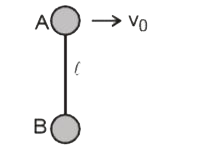Text Solution
Verified by Experts
The correct Answer is:
|
Topper's Solved these Questions
10 ROTATIONAL
MOTION|Exercise Exercise - 3 (Level - II)|20 VideosView Playlist10 ROTATIONAL
MOTION|Exercise Exercise - 4 (Level - I)|24 VideosView Playlist10 ROTATIONAL
MOTION|Exercise Exercise - 2 (Level - II)|25 VideosView PlaylistALTERNATING CURRENT
MOTION|Exercise EXERCISE - 4 (LEVEL - II)|14 VideosView Playlist
Similar Questions
Explore conceptually related problems
Knowledge Check
Similar Questions
Explore conceptually related problems
MOTION-10 ROTATIONAL-Exercise - 3 (Level - I)
- In the figure A and B are two blocks of mass 4 kg and 2 kg respectivel...
10:07
|
Play - A cylinder of height h, diameter h//2 and mass M and with a homogene...
05:36
|
Play - A mass m is attached to a pulley through a cord as shown in figure. Th...
08:04
|
Play - Figure shows two blocks of mass m and m connected by a string passing ...
04:32
|
Play - A particle having mass 2 kg is moving along straight line 3 x + 4 y =...
04:57
|
Play - A particle having mass 2 kg is moving with velcoity (2 hat(i) + 3 hat(...
02:50
|
Play - A uniform square plate of mass 2.0 kg and edge 10 cm rotates about one...
04:20
|
Play - A wheel of moment of inertia 0.500 kg-m^2 and radius 20.0 cm is rotati...
03:51
|
Play - A uniform circular disc can rotate freely about a rigid vertical axis ...
04:13
|
Play - Two identical discs are positioned on a vertical axis as shown in the ...
03:27
|
Play - Two small spheres A & B respectively of mass m & 2m are connected by a...
05:51
|
Playing Now - A sphere of mass m rolls on a plane surface.Find its kinetic energy at...
08:23
|
Play - A cylinder rolls on a horizontal polane surface. If the speed of the c...
05:25
|
Play - A small spherical ball is released from a point at a height h on a rou...
03:08
|
Play - A sphere starts rolling down an incline of inclination theta. Find the...
03:34
|
Play - A solid uniform sphere of mass m is released from rest from the rim of...
03:52
|
Play - A uniform rod of mass m and length l is struck at an end by a force F...
04:01
|
Play - A uniform rod of mass m and length l is struck at an end by a force F...
04:01
|
Play - A uniform rod of mass m and length l is struck at an end by a force F...
04:01
|
Play - A uniform rod of mass m and length l is struck at an end by a force F...
02:35
|
Play
